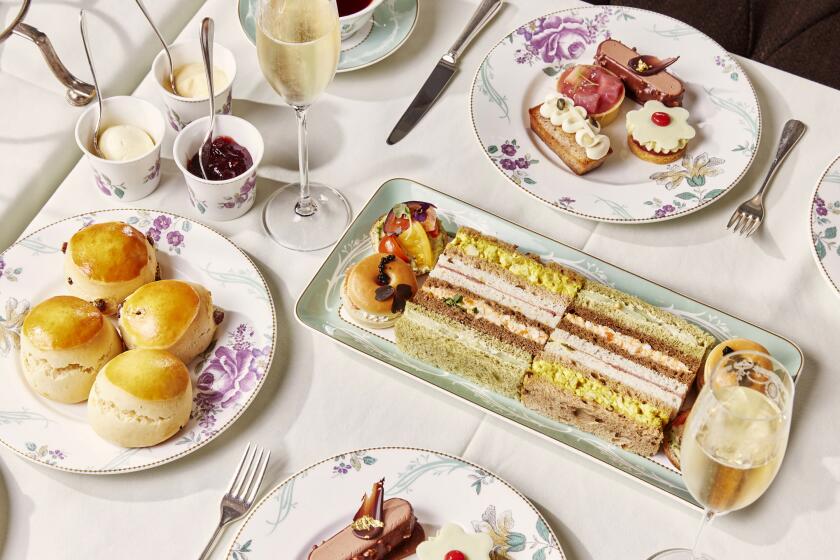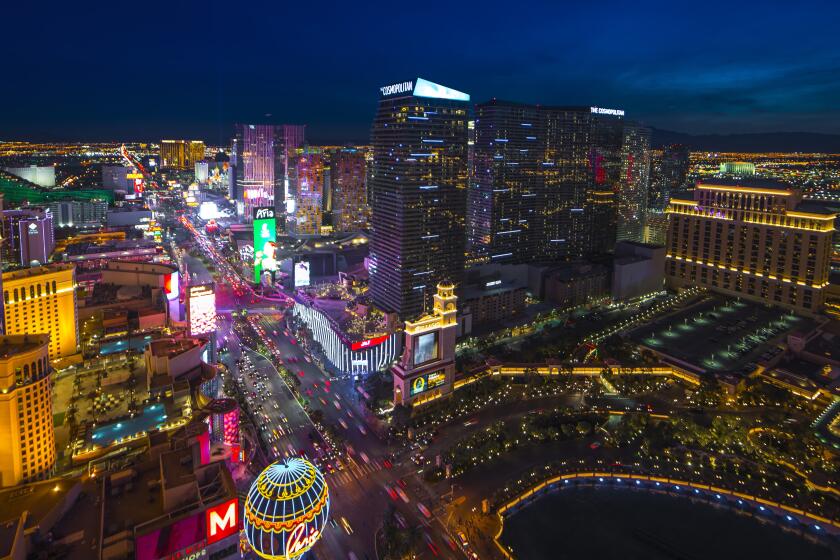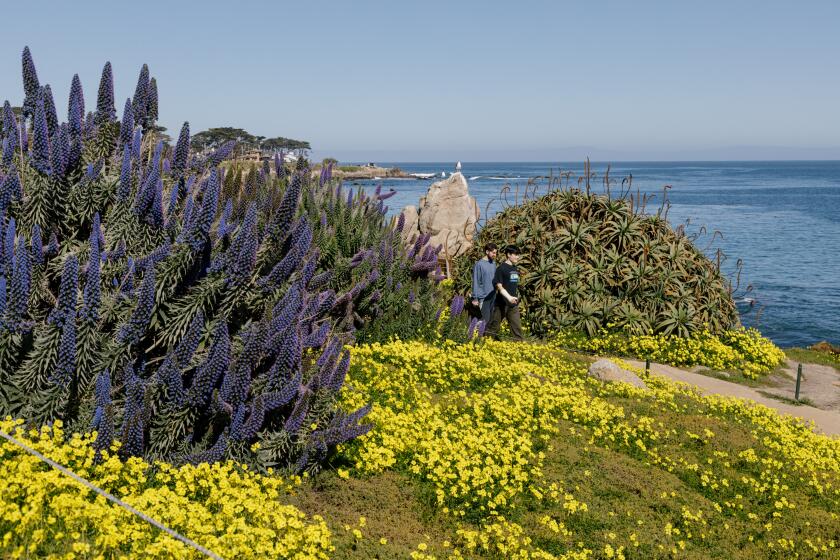Enjoying the Marquesas’ pristine Polynesia
The road snaked along the coast as a narrow track hewn into the cliffs, hundreds of feet above the restless ocean. As I gripped the wheel of our rented four-wheel-drive, crawling along in first gear, my girlfriend Bridget Yin seemed unfazed. “Look down there!” she called as another sapphire cove came into view.
It was our first full day on Hiva Oa, second-largest of the dozen islands comprising the Marquesas. Bridget and I had come to experience raw tropical beauty and to glimpse Polynesian life outside the polished resorts.
The Marquesas are volcanic peaks rising from the seafloor some 850 miles northeast of Tahiti. Unlike classic South Pacific atolls, which have protective coral reefs, the islands are battered by powerful currents. Calmer waters and sandy beaches are found in bays carved into the coastlines.
On windward slopes and in canyons, the Marquesas boast lush vegetation, while in lees the islands can be desertlike. At higher elevations, where serrated spires pierce the clouds, the rain-soaked soil gives rise to expansive forests and fern-covered ridges.
Despite scenery so spectacular that it borders on surreal, few Americans visit the Marquesas. One reason may be remoteness — it’s the island chain farthest from continental landfall anywhere in the world. Getting to the Marquesas from LAX requires an eight-hour flight to Tahiti, followed by a 31/2 hour flight on a turboprop.
Another reason why few Americans visit may involve the islands’ status as French territory. Rita Lieugard, a Parisian traveling with her husband, Sullivan, told me that “in France everyone knows of the Marquesas — you learn about them in school.”
I learned of the Marquesas because of an evocative verse in the Crosby, Stills & Nash song “Southern Cross.” Hearing the words “off the wind on this heading lie the Marquesas” piqued my interest.
After steering down switchbacks into the village of Puamau, I followed hand-lettered signs to an archaeological site featuring five tikis carved from basalt. One of them, depicting a warrior chief, is the largest tiki in French Polynesia.
Bridget and I were alone as we walked through the ruins. Afterward, we parked under a palm tree and strolled barefoot where foamy waves mixed with cappuccino sand. Like most beaches, it was deserted; the Marquesas have fewer than 10,000 residents dispersed among six inhabited islands.
But the delicious solitude and unspoiled landscape meant enduring modest hardships. The roads were often unpaved and unmarked. Mosquitoes and “nono” flies lurked in the tropical vegetation. Cellphone service was practically nonexistent. I longed for a good cup of coffee.
On Hiva Oa we stayed at Hanakee Pearl Lodge, a collection of bungalows on a hillside overlooking Taaoa Bay. Under the half-board plan, we’d start our day with croissants on the terrace and end with entrees in the dining room.
Because restaurants were scarce, we’d usually buy lunch at a market. The ubiquitous baguette cost only 55 Polynesian francs (about 60 cents). Fruit and coconuts were also plentiful, but a wedge of imported brie cheese cost 600 francs (nearly $7).
Bridget and I found no nightlife other than impromptu gatherings of young people down by the water. We learned to turn in early and rise with the roosters — plenty of those live on the islands, crowing at first hint of light.
Downhill from the lodge was Atuona, largest town on Hiva Oa and former home of post-impressionist Paul Gauguin. His notorious Maison de Jouir (“House of Pleasure”) is a museum.
Our flight to Ua Pou, third-largest island in the chain, was an adventure. Beforehand, I met the pilot David Fornet, and he spoke fondly of the Twin Otter, a vintage 19-seat aircraft used for inter-island hops.
Sitting behind David as we approached Ua Pou, I could see the runway ahead — it started at water’s edge and ended at a mountain wall. The small plane pitched and rolled in turbulent air, but David set it down with a firm touch.
From the moment we landed, my gaze was captivated by Ua Pou’s fantastical skyline. The island bristles with spires, including Mount Oave, which at 4,035 feet is highest elevation in the Marquesas.
Ato Teikiehuupoko of family-owned Pension Vehine greeted us in perfect English. Although most islanders speak French along with Marquesan dialects, Bridget and I got by with only English and a handful of words like “oui” and “merci.”
As Ato drove through arid hills to the principal town of Hakahau, he explained that water management is an ongoing issue. “We have droughts lasting several years, like you experience in California.”
It was September, start of the dry season that lasts until March. Daily temperatures ranged from mid-70s at dawn to high 80s in the afternoon, which explained why shops shut down for several hours after lunch.
The next day, Ato arranged for his friend Raïssa Tekohuotetua to guide us on a hike. Bridget and I donned boots and broad-brimmed hats, but 20-something Raïssa and her 10-year-old daughter Vaihinitapu wore the outfit of choice in the Marquesas: flip-flops, board shorts and a T-shirt.
Ato dropped us at a goat farm, and Raïssa started up a rugged path. We ascended to a saddle with views into palm-veiled Hakamoui Valley. Raïssa explained that in ancient times the valley “was the home of Heato, a great king.” She also spoke of how “missionaries ruined my people’s way of life.”
In 1595, a Spanish explorer spotted Fatu Hiva, southernmost of the chain, and named the islands Las Marquesas de Mendoza in honor of his sponsor, the viceroy of Peru. Catholic missionaries arrived in the 1800s, banning ancient traditions such as dancing. With the influx of Europeans, disease decimated the islands’ populations.
We followed Raïssa down to a lonely beach. As Bridget and I shed a layer of clothing so we could frolic in the waves, Raïssa rolled down the waistband of her shorts to reveal an intricate ribbon of tattoos.
Tattooing and other traditions have staged a comeback. Raïssa said she planned to get more tattoos before dancing in the Marquesas Arts Festival, a grand celebration held every four years. The next festival starts on Dec. 15 on Hiva Oa.
That evening, Bridget and I strolled from our garden bungalow to Pension Vehine’s roadside restaurant. A raucous party was under way. The gathering included colorfully dressed islanders, a Frenchman with pierced ears and rakish haircut, and a Marquesan transvestite.
They welcomed me and Bridget with bottled beer and hand-rolled cigarettes of Bison tobacco, a local favorite. “There are no strangers here,” said Ato.
Among the revelers were two French gendarmes on a three-month rotation to Ua Pou. They told me that because of the island’s close-knit family structure, crime is almost nonexistent.
Not to say that everything in the Marquesas seemed idyllic. I observed some islanders living in squalor. Bridget, an ICU nurse, questioned the availability of medical care in remote villages.
Even so, the Marquesas came as close to paradise as anyplace I’d been. I marveled at the pristine seawater and sparsity of litter. Although islanders light fires to clear vegetation, and occasionally smoke stung my nose, most often the breeze was ambrosial.
The Marquesas also had an aura of serenity. There were no beachfront resorts, no jet-skis or helicopters. Rose Corser, who first sailed to the islands from San Diego 32 years ago, credited this to the government.
“If the islands were under American control, there would be an international airport and all the roads would be paved,” she opined. “The French leave the Marquesas alone.”
Rose runs a cultural museum at the western end of Taiohae, the main town on Nuku Hiva, largest island of the Marquesas. Nuku Hiva, the final stop on our 12-day journey, was the location for season four of “Survivor.”
We stayed in a harbor-view bungalow at Keikahanui Pearl Lodge, operated by Nathalie Volle, an elegant Frenchwoman. She offered bikes for loan, so one afternoon we pedaled to the marina — the Marquesas are first stop for “yachties” sailing to the southern islands from Hawaii or Acapulco.
The Aranui, a hybrid freighter/cruise ship, had been in port earlier in the day. It makes a two-week circuit delivering supplies to the Marquesas and is renowned among travelers who favor a comfortable and coordinated tour of the islands’ wonders.
Nuku Hiva’s wonders include Vaipo Waterfall, which at 1,148 feet is highest waterfall in French Polynesia. But for me the high point was a journey to the island’s north side.
A twisting road descended from cool forest to the garden village of Taipivai, where a river widens into a lagoon as it flows into the bay. This is the place that inspired Herman Melville to write the 1846 book “Typee,” a sensationalist account of island life.
Continuing over and down a 1,600-foot pass, the road brought Bridget and me to Haitheu. Halfway down the main street, a shady lane running parallel to the beach, we found Chez Yvonne-Restaurant Hinakonui. We sat under thatched roof and lunched on curried goat meat, and for dessert, fresh-brewed espresso.
Kari, a freelance writer who lives in San Clemente, can be contacted at dougkari@yahoo.com.
If you go
These websites have useful information about visiting the Marquesas:
www.tahiti-tourisme.com/islands/marquesas/marquesas.asp
www.lonelyplanet.com/tahiti-and-french-polynesia/marquesas-islands
Get U-T Arts & Culture on Thursdays
A San Diego insider’s look at what talented artists are bringing to the stage, screen, galleries and more.
You may occasionally receive promotional content from the San Diego Union-Tribune.





